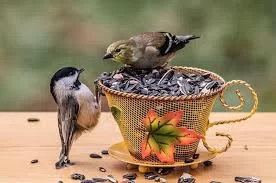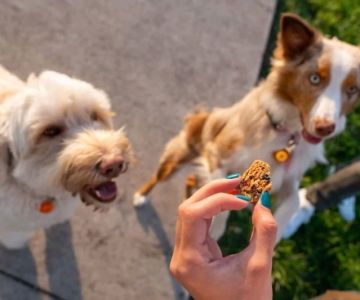- Understanding the Benefits of Homemade Bird Seed Mixes
- Choosing Ingredients for Nutritious Bird Seed Blends
- Step-by-Step Guide to Making DIY Bird Seed Mixes
- Real-Life Stories of Successful Bird Feeding with Homemade Mixes
- Professional Tips for Feeding Wild Birds Safely
1. Understanding the Benefits of Homemade Bird Seed Mixes
Homemade bird seed mixes offer a fantastic way to attract a variety of wild birds while providing them with the best nutrition possible. Unlike many commercial blends, which can include fillers or preservatives, DIY mixes allow you to control every ingredient, ensuring a natural, wholesome diet for your feathered visitors.
Creating your own bird seed blend supports local wildlife by catering to specific bird species’ dietary preferences and seasonal needs. It can also be more cost-effective and environmentally friendly by using locally sourced or organic seeds.
Moreover, homemade bird seed mixes can reduce waste since you can customize quantities to suit your feeding routine, avoiding the spoilage common with large commercial bags.
1.1 Why Custom Blends Matter for Bird Health
Different bird species require different nutrients. For instance, finches favor small seeds like millet, while cardinals prefer sunflower seeds. By mixing ingredients thoughtfully, you encourage a diverse bird population and help maintain local ecosystems.
Natural seed blends also reduce the risk of mold or harmful chemicals sometimes found in mass-produced mixes, promoting safer feeding experiences.
1.2 Environmental and Economic Advantages
Homemade blends often rely on sustainable seed options and avoid unnecessary packaging, reducing your ecological footprint. Additionally, buying seeds in bulk or growing your own can save money over time.
2. Choosing Ingredients for Nutritious Bird Seed Blends
Selecting the right seeds and supplements is crucial when crafting homemade bird seed mixes. Quality and variety ensure that your mix will appeal to many species and meet their nutritional needs.
2.1 Popular Seeds and Their Benefits
Black oil sunflower seeds are rich in fat and energy, making them favorites among many birds. Millet is excellent for smaller birds like sparrows, providing easily digestible carbohydrates. Nyjer seed attracts finches, and safflower seeds are ideal for cardinals and grosbeaks.
2.2 Adding Nutritional Boosters
In addition to seeds, you can include dried fruits, nuts, or mealworms to increase protein and vitamins. However, these additions should be given sparingly and adjusted to local bird populations and seasons.
2.3 Avoiding Harmful Ingredients
Avoid seeds treated with pesticides, artificial colors, or fillers like wheat or red millet, which some birds might reject or which may cause digestive issues.
3. Step-by-Step Guide to Making DIY Bird Seed Mixes
Making homemade bird seed mixes is simple and rewarding. Follow these steps to prepare blends suited for your backyard birds.
3.1 Assess Your Local Bird Species
Observe the birds visiting your area or consult local birdwatching groups to identify species and their seed preferences.
3.2 Source High-Quality Ingredients
Purchase fresh, untreated seeds from reputable suppliers or consider growing some seeds yourself if feasible.
3.3 Create Your Blend
Combine seeds based on your observations. For a general mix, a balanced ratio could be 50% black oil sunflower seeds, 25% millet, 15% cracked corn, and 10% safflower.
3.4 Store Properly
Keep your homemade bird seed mix in airtight containers, away from moisture and pests to preserve freshness and nutritional value.
4. Real-Life Stories of Successful Bird Feeding with Homemade Mixes
One avid birder, Emily, shared how switching to a homemade seed mix transformed her backyard visits. By tailoring her blend to include more nyjer seed and sunflower seeds, she attracted a variety of finches and cardinals that had rarely visited before.
Another story comes from John, who noticed his local woodpeckers avoiding commercial blends. After crafting a special mix including peanuts and sunflower seeds, he enjoyed daily visits from these vibrant birds, enriching his nature-watching experience.
These examples highlight how personalized mixes can deepen your connection with wildlife and support local biodiversity.
5. Professional Tips for Feeding Wild Birds Safely
Feeding wild birds responsibly enhances their survival and well-being. Experts at Hidden Brook Veterinary recommend several best practices to ensure your bird feeding efforts are beneficial.
5.1 Clean Feeding Stations Regularly
To prevent disease spread, clean feeders and surrounding areas frequently. This is particularly important when feeding high volumes of birds.
5.2 Provide Fresh Water
Birds need fresh water for drinking and bathing. Including a clean water source near your feeders encourages healthy visits.
5.3 Avoid Overfeeding
While generous feeding is kind, excess food can attract pests or cause spoilage. Adjust feeding amounts seasonally and monitor consumption.
For expert advice on bird nutrition and to find the best ingredients or feeders, Hidden Brook Veterinary offers personalized support and quality products tailored to your bird feeding goals.












